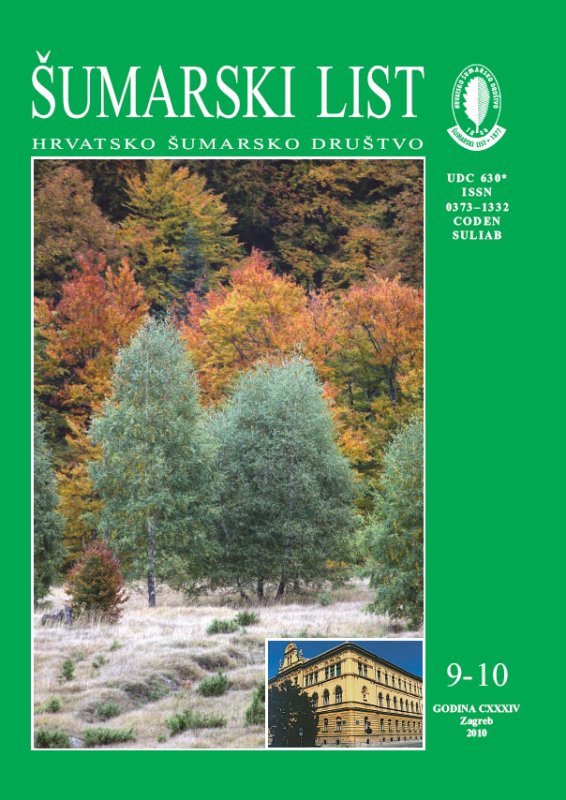
broj: 9-10/2010
pdf (7,71 MB) |
|
||||||||||||||
| RIJEČ GLAVNOGA UREDNIKA | ||
| Branimir Prpić | ||
| THE NEW FOREST LAW pdf HR EN | 445 | |
| IZVORNI ZNANSTVENI ČLANCI | ||
| Pandža,M., V.Krpina | UDK 630* 187 + 188 (001) | |
| Forest Vegetation of the Island of Vrgada and its Islets (Dalmatia, Croatia) pdf HR EN | 447 | |
| Pejnović,D., K.Krapinec, M.Slamar | UDK 630* 156 (001) | |
| Hunters in Croatia as a Socio-Geographic Group and their Socio-Demographic Characteristics pdf HR EN | 461 | |
| Šerić Jelaska, L., A. Ješovnik, S. D. Jelaska, A. Pirnat, M. Kučinić, P. Durbešić | UDK 630* 114.6 + 411 (001) | |
| Variations of Carabid Beetle and Ant Assemblages, and their Morpho-ecological Traits within Natural Temperate Forests in Medvednica Nature Park pdf HR EN | 475 | |
| Čas, Miran | UDK 630* 156 (001) | |
| Disturbances and Predation on Capercaillie at Leks in Alps and Dinaric Mountains pdf HR EN | 487 | |
| PRETHODNO PRIOPĆENJE | ||
| Matošević, D., M. Pernek, B. Hrašovec | UDK 630* 453 | |
| First Record of Oriental Chestnut GallWasp (Dryocosmus kuriphilus) in Croatia pdf HR EN | 497 | |
| Summary: Oriental chestnut gall wasp (DryocosmuskuriphilusYat su matsu) (Hymenoptera: Cynipidae) is new invasive species in Europe and important pest on sweet chestnut (Castanea sativa Mill.). It is on quarantine species lists in Europe as well as in Croatia. The species originates from China and it was first introduced to Europe to Italy in 2002. It has also been recorded in Slovenia, France, Hungary and Switzerland. In May 2010. it was recorded in Croatia for the first time. Oriental chestnut gall wasp has one generation per year (Figure 1). Adult wasps (only females are known) emerge from galls from mid June until the end of July and lay eggs in the buds. The wasp overvinters as early larval instar in buds and cannot be detected without large magnification lense. In spring when new shoots and leaves emerge the galls develop on the leaf midveins (Figure 2) or shoots. The galls, 5–20 mm in diameter, contain one or usually several chambers with white larvae, later pupae. Young galls are green, later rose-coloured and can be easily detected on sweet chestnut shoots. Old galls are brown, wood-like and remain attached to the tree up to two years (Figure 3). The spread of oriental gall wasp occurs mainly by transport of infected plant material (scions for grafting, plants for planting) into new areas. Locally, the wasps spreads by active flight or passive (aided by wind or human dispersal) transport. The galls disrupt twig growth and reduce fruiting. Various authors consider it as a seroius pest on sweet chestnut trees. Several control measures against this pest have prooved themselves uneffective. Pruning of infested shoots can be done in small orchards but this method is uneffective in forests. Some parasitoid species, e.g. Torymus sinensis, can reduce populations of oriental chestnut gall wasp and this species has already been introduced as biological control agent in Japan, Korea and Italy. Oriental sweet chestnut gall wasp was first recorded in Croatia on 21 May 2010 in Lovran and after that in several other sweet chestnut forests (Table 1, Figure 5). According to the number of galls per shoot it can be estimated that on the localities Lovran, Samobor and Ozalj (single galls per leaf/shoot) the pest has recently been introduced. Localities in Zagreb had high infestation rates (numerous galls per leaf/shoot) and it can be estimated that the pest is here present since 2007 or 2008. The spread forecast for Croatia for the following years is given. Intensive spread can be expected in all areas where sweet chestnut is grown, lower intensity in Istria, surroundings of Karlovac and Banija, and much higher intensity and quicker spread in Zagreb area, Hrvatsko zagorje and Samoborsko gorje. The trasport of infested planting material to uninfected zones (region of hills in Slavonia) shoud be strongly avoided. Key words: damage; galls; quarantine pest; sweet chestnut | ||
| PREGLEDNI ČLANCI | ||
| Tomićević, J., M. A. Shannon, D. Vuletić | UDK 630* 903 + 907.1 | |
| Developing Local Capacity for Participatory Management of Protected Areas: The Case of Tara National Park pdf HR EN | 503 | |


